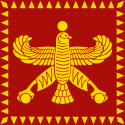یهود مدینه
یهود مدیناتا ایالت یهودیه | |||||||||
|---|---|---|---|---|---|---|---|---|---|
| ح. ۵۳۹ پ٫ م–۳۳۲ پ. م | |||||||||
 جایگاه یهودیه در قلمرو شاهنشاهی هخامنشی با رنگ صورتی مشخص شده است | |||||||||
| وضعیت | ایالت شاهنشاهی هخامنشی | ||||||||
| پایتخت | اورشلیم ۳۱°۴۷′ شمالی ۳۵°۱۳′ شرقی / ۳۱٫۷۸۳°شمالی ۳۵٫۲۱۷°شرقی | ||||||||
| زبان(های) رایج | آرامی باستان ، عبری توراتی، پارسی باستان | ||||||||
| دین(ها) | معبد دوم یهودیت، سامری | ||||||||
| نام(های) اهلیت | یهودیان، بنیاسرائیل | ||||||||
| دوره تاریخی | Axial Age | ||||||||
| ح. ۵۳۹ پ٫ م | |||||||||
| ۵۳۹ پ. م | |||||||||
• فرمان کوروش به آزادسازی اسیران یهودی در بابل | ۵۳۸ پ. م | ||||||||
• بازگشت یهودیان به صهیون | ۵۳۸ پ. م | ||||||||
• ساخت معبد دوم اورشلیم | ۵۲۰–۵۱۵ پ. م | ||||||||
| ۳۳۲ پ. م | |||||||||
| واحد پول | دریک، سیگل | ||||||||
| |||||||||
| امروز بخشی از | |||||||||
یهود مدینه[۱][۲][۳][۴][۵] یا یهود مدینتا [۶][۷][۸][۹] یک استان اداری خودمختار از شاهنشاهی هخامنشی بود. این یکی از چندین ایالت از این قبیل در سرزمین اسرائیل بود. بقیه ایالتها موأب، آمون، گیلاد، سامریه، اشدود و پادشاهی ادوم بودند، که پنجمین ساتراپی هخامنشی عبر-ناری (ساتراپی هخامنشی) را تشکیل میدادند.[۱۰] این بنا که در یهودیه قرار داشت، دو قرن به حیات خود ادامه داد تا اینکه در عصر هلنیستی پس از جنگهای اسکندر مقدونی گنجانده شد.
پس از سقوط بابل در سال ۵۳۹ پ. م، امپراتوری بابل نو توسط ایرانیان ضمیمه شد. استان پارسی یهود جانشین استان پیشین یهود (استان بابل) شد که پس از فتح پادشاهی یهودا توسط بابلیان به دنبال شورشهای یهودا علیه بابل شکل گرفت. به دلیل تأثیرات طولانی مدت اسیران یهودی در بابل، این استان نسبت به یهودای باستان جمعیت کمتری داشت. «یهود مدینه» نام زبان این استان بود و اولین بار توسط بابلیها در زمان حکومت خود بر همان منطقه قبل از فتح پارسیان معرفی شد.[۱]
برپایی یهود مدیناتا نزدیک به دو سده ادامه داشت تا این که با یورش اسکندر مقدونی در امپراتوریهای هلنی آمیخته شد.
جستارهای وابسته
[ویرایش]منابع
[ویرایش]- ↑ ۱٫۰ ۱٫۱ Crotty, Robert Brian (2017). The Christian Survivor: How Roman Christianity Defeated Its Early Competitors. Springer. p. 25 f.n. 4. ISBN 978-981-10-3214-1. Retrieved 28 September 2020.
The Babylonians translated the Hebrew name [Judah] into Aramaic as Yehud Medinata ('the province of Judah') or simply 'Yehud' and made it a new Babylonian province. This was inherited by the Persians. Under the Greeks, Yehud was translated as Judaea and this was taken over by the Romans. After the Jewish rebellion of 135 CE, the Romans renamed the area Syria Palaestina or simply Palestine. The area described by these land titles differed to some extent in the different periods.
- ↑ Spolsky, Bernard (2014). The Languages of the Jews: A Sociolinguistic History. Cambridge University Press. p. 39. ISBN 978-1-107-05544-5. Retrieved 4 May 2020.
- ↑ Gooder, Paula (2013). The Bible: A Beginner's Guide. Beginner's Guides. Oneworld Publications. p. 27. ISBN 978-1-78074-239-7. Retrieved 4 May 2020.
- ↑ "medinah". Bible Hub: Search, Read, Study the Bible in Many Languages. Retrieved 4 May 2020.
- ↑ Philologos (21 March 2003). "The Jews of Old-Time Medina". Forward. The Forward Association. Retrieved 4 May 2020.
...in the book of Esther,...the opening verse of the Hebrew text tells us that King Ahasuerus ruled over 127 medinas from India to Ethiopia — which the Targum, the canonical Jewish translation of the Bible into Aramaic, renders not as medinata, 'cities,' but as pilkhin, 'provinces.'
- ↑ Kalimi, Isaac (2005). An Ancient Israelite Historian: Studies in the Chronicler, His Time, Place and Writing. Studia Semitica Neerlandica. BRILL. pp. 12, 16, 89, 133, 157. ISBN 978-90-04-35876-8. Retrieved 28 September 2020.
- ↑ Bar-Asher, Moshe (2014). Studies in Classical Hebrew. Studia Judaica, Volume 71 (reprint ed.). Walter de Gruyter. p. 76. ISBN 978-3-11-030039-0. ISSN 0585-5306. Retrieved 28 September 2020.
- ↑ Fleishman, Joseph (2009). Gershon Galil; Markham Geller; Alan Millard (eds.). To stop Nehemiah from building the Jerusalem wall: Jewish aristocrats triggered an economic crisis. Homeland and Exile: Biblical and Ancient Near Eastern Studies in Honour of Bustenay Oded. Vetus Testamentum, Supplements. Brill. pp. 361-390 [369, 374, 376, 377, 384]. ISBN 978-90-474-4124-3. Retrieved 28 September 2020.
- ↑ Kochman, Michael (1981). Status and Territory of 'Yehud Medinta' in the Persian Period (dissertation) (به عبری). Hebrew University of Jerusalem. p. 247. ISBN 978-3-16-145240-6. Retrieved 28 September 2020 – via "Bibliography" (p. 247; just the work's title) in Kasher, Aryeh. "Jews, Idumaeans, and Ancient Arabs: Relations of the Jews in Eretz-Israel with the Nations of the Frontier and the Desert During the Hellenistic and Roman Era (332 BCE-70 CE)". Mohr Siebeck, 1988, Texts and Studies in Ancient Judaism Series (Volume 18), ISBN 978-3-16-145240-6.
- ↑ Gerald A. Klingbeil, When Not to "Tie the Knot”: A Study of Exogamous Marriage in Ezra-Nehemiah Against the Backdrop of Biblical legal Tradition,' دانشگاه اندروز 2016 pp.156-184 p.158.



